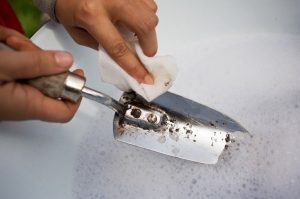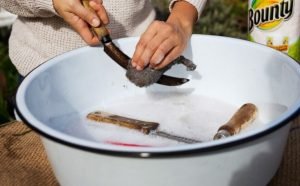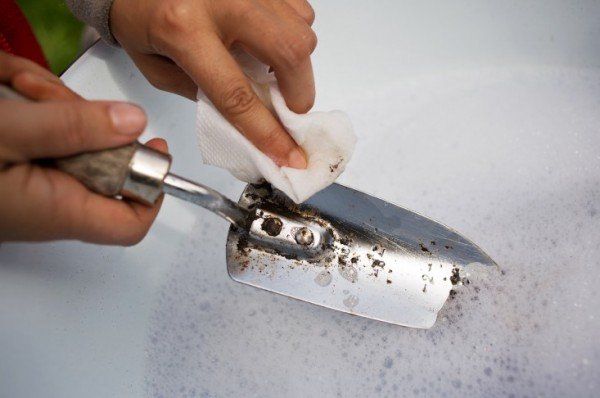Translated by Nick R
Many factors can become carriers of diseases or pests to your plants, one of them is garden tools. Even though they’re very helpful for gardening activities, they can become a pain in the neck if you don’t properly maintain them.
That’s why in this blog I’d like to talk about how important garden tools are, what can happen if you don’t clean and take care of them properly, some tips to keep them in perfect condition and, finally, some recommendations for you to buy the best tools.
Table of Contents
The importance of garden tools
As a gardener, you surely know how important it is to take care of your garden and keep it up to date all the time. Besides, gardening is an activity that offers you therapeutic, nutritional, medicinal and ornamental benefits thanks to the plants you may have.
Well, given the above, it’s essential to use tools to make handling the exterior of your house much easier. In our blog about the most important tools for the garden, you’ll find a list of the tools you need to maintain this area.
These tools are important because they help you to:
- Prune the plants: Either they are in pots and thus are short or those that are planted directly in the ground and are very tall.
- Clean the soil: Some species of plants lose their leaves in autumn and therefore it’s important to collect them to make mulch or avoid dirt in the garden.
- Collect fruits: It helps to pick fruits for consumption or sale, as this process must be done carefully so that the fruits don’t get spoiled.
- Sowing the plants: You’ll need to prepare the soil, dig holes, and mix the substrate, amongst others.
Apart from the above, you have the convenience of using manual tools, such as scissors, shovels, or rakes, as well as mechanical tools, such as pruners, hedge trimmers, or chainsaws. They also come in various colors (if you like to combine them), sizes (as there are tools for miniature gardens), and materials (which can ensure the good or bad durability of the tool).
Another noteworthy feature of tools is that they’re helpful not only for plants but some are also for your own protection. It includes gloves, goggles, overalls, floor cushions, hats to protect you from the sun, and even special suits in case you have to handle chemicals, like pesticides.
Your safety is also important, and we don’t want you to have any serious accidents, right? The goal is that you enjoy your garden and can maintain it as you like with the help of the right tools.
What happens when you neglect to care for your tools?
It goes beyond just using the right tools, making the garden look beautiful, and leaving it that way. It’s fundamental that, just as you take care of your plants, you take care of your tools because many factors, that I’ll mention below, depend on it.
Transmission of diseases or pests to plants
As we’ve mentioned in other blogs, one of the ways in which plants get infected by pests or diseases is through tools or the people who handle these objects. This happens due to poor hygiene.
It’s always essential to properly clean and sanitize the tools before using them. When you’re done using the tools, clean them again to remove any soil residue and dry the tools thoroughly so moisture doesn’t attract fungus.
These are some diseases that can be transmitted to plants due to poor tool maintenance.
Phytopthora infestans – Gout, late blight
This disease can affect the leaves, stems, or fruits of plants and is commonly found in areas where the temperature lies between 15 to 22 °C (59 to 72 °F) and humidity is around 80%.
If a plant’s leaves or stem is severely affected by this disease, the spores of the fungus can be spread by wind and affect nearby plants, along with irrigation water droplets to splash onto other crops and tools that were not properly washed.
This disease causes the leaves, stems, or fruits of plants to present brown or chestnut-colored spots and have a wet appearance. The underside of the leaves shows the same lesions along with slight white ash in the center.

Botrytis cinerea – Gray Mold
This is a fungus that develops in areas with constant rainfall, high humidity, and temperatures from 15 to 22 °C (59 to 72 °F). It can be spread by wind, water splash from irrigation water, and poorly sanitized tools.
This disease affects the flowers, stems, and fruits of the plants. It can cause dark brown spots on the tips of leaves as well as soft, watery, gray, or dark brown lesions.

Pythium, Rhizoctonia, Fusarium, Phytophthora, Sclerotium (fungal complex) – Dry leg, seedling rot.
This disease affects the seedlings that are germinating. It’s more likely to develop under various conditions: temperatures from 18 to 24°C, seedbeds located in poorly lighted spots with too much vegetation, in the irrigation water, and the use of tools that have contact with infected soil.
Also, this disease leads seeds to grow unevenly and ultimately rot. When it attacks seedlings, it causes the roots to weaken, the plant base is strangled, the stem is affected, and thus the plant dies prematurely.

Erwinia sp – wilt, soft rot
This disease can be caused by excessive moisture at the bottom of the plant stem and is spread through contaminated tools and rainwater. It initially affects the leaves causing wilting, and when very advanced, it affects the whole plant.
During pruning, it’s advisable to wash the tools and the operator’s hands very well. This way, the disease won’t spread to the rest of the plants and affect the whole crop.
Rust on tools
When working for a long time in the garden, it’s common to overlook the proper cleaning and maintenance of the tools at the end of the activities. This may happen due to forgetfulness or fatigue, but it results in deterioration and rust on your garden tools.
Rust is a reddish-colored layer that can form on iron or other metal surfaces. It’s caused by the moisture to which the tools may be exposed.
The best solution I can give you to keep your tools safe is to store them in a cabinet or shed where they are protected from environmental conditions and to clean them always after use.
You can use a rag or a brush, water, and soap to wash them properly by removing all the residues. Then, you must dry them very well, and apply some mineral oil if you want. The latter is to clean and lubricate the tools and maintain optimum performance.
Below, I’ll explain what other materials you can use and how you can clean these valuable tools.
Monetary expenses
While it’s true that you can use some reusable or inexpensive products or materials, sometimes it’s necessary to invest good money in your garden. For example, the tools that you’ll use to manipulate the plants, substrates, and others. It’s best to buy tools whose material guarantees their durability since the goal is to use them as long as possible.
An essential tool you must have in the garden is the pruning shears, either 1-handed or 2-handed. They should be made of a resistant material as they’ll be used for pruning different species of plants.
You can find stainless steel shears, which are highly resistant to corrosion. There are also carbon steel shears, which are more durable and malleable. Finally, some scissors have titanium-coated blades that make them lighter and more resistant to corrosion.
Likewise, you can find different garden tools made of this or other materials. It all depends on your needs and budget; however, it’s not enough to have a sturdy tool.
It’s necessary to maintain and clean your tools every time you use them and store them in a proper place. Otherwise, they’ll get damaged very fast, and you’ll have to replace them again and again. And I’m sure you don’t want to experience this; they can be costly, and you might start to get discouraged about taking care of your garden.
How to take care of your tools?
Now that you know how important tools are and what can happen if you don’t take care of them, I want to explain step by step how to clean them so as to keep your tools in optimal conditions.
Step 1. Prepare the cleaning materials
To clean your tools, you’ll need the following materials:
- Dish sponge or a rag to wash the tools.
- Steel wool sponge to remove rust or stubborn dirt
- Water
- A bucket of water or a space for washing up
- Kitchen soap
- Vinegar, baking soda, Coca-Cola or lemon, and salt to apply to rusted tools
- Alcohol to disinfect the tools before use
- Vegetable oil to lubricate tools
- Coconut oil in case you want to coat the handles of the tools
Step 2. Washing the tools
Once the materials are ready, take your tools to wash them. You can start with the smaller ones as they are easier to submerge in the bucket with water and dish soap.
With the dish sponge or the rag, scrub your tools until all the dirt is removed. You can add some baking soda to the water to make the tools shinier.

The larger tools can be washed on a table or on the floor with the same sponge. And in case any of these have a little rust or parts where dirt is stored and thus require more effort you can use a steel sponge.

When you have finished removing the dirt, rinse the tools to remove the soap and let them dry, either in the open air or using another cloth to wipe them dry. You must make sure that there are no traces of moisture on them.
Step 3. Sanitizing and lubricating the tools
Once the tools are completely dry, you can rub them with a cloth or napkin and disinfect alcohol. This way, they won’t transmit diseases to plants, whether they have the ailment attached to them or for mere prevention.
After this process, apply the vegetable oil or coconut oil. You can use a kitchen napkin to spread all over the tool. They’ll help protect the tool from rusting.
To finish, store your tools in the closet or whatever place you have set aside for them. Remember that this space must shelter your tools from those factors that contribute to oxidation, such as rain or direct sunlight.
5 garden tools recommendations
Now that you know how to take care of your tools so that they don’t get damaged or transmit diseases to your plants, I want to show you some of my favorite ones. As you may have already seen, tools come of all sizes and kinds for every need in your garden.
I’ll show you some hand tool kits and one or two mechanic tools.
Bonsai tool kit
As I mentioned in the bonsai blog, it’s essential to prune, fertilize, transplant and pot these beautiful miniature trees. This tool kit will make your job easier as they are customized to the right proportions and sizes for these plants.
Fruit shears
In our blog about fruit trees, we told you that it’s vital to know how to cut fruits to avoid spoiling them. That’s why fruit shears are perfect for this process.
Generally, the handle of this tool is wrapped in rubber, and its blade is made of steel. Its design is specialized to be used with one hand, but you must be careful because it’s very sharp.
Electric hedge trimmer
This is an ideal tool for pruning the hedges in your garden and makes shaping them to your liking much easier. This is a hedge cutter characterized by being very light and easy to handle.
You can find it with blades of different sizes, it can vary according to your needs.
Basic gardening tool kit
This kit will be helpful in case you’re starting with gardening. It consists of about 10 pieces and a case to store and keep the tools protected. The handle of the tools is usually made of plastic, and the blade is made of stainless steel, which makes them durable.
It’s perfect as a gift for a friend or family member who’s just starting out in the delightful world of gardening.
2-pronged weeding hoe
This tool helps you remove weeds from the garden, open ditches or gutters, stir the soil, and do similar activities. The handle is made of wood or steel, and the blade is of high-quality carbon steel.
It’s a lightweight tool that allows you to work more comfortably and without much effort.
__________________________________________________________________
We’ve come to the end of this blog on taking care of garden tools. I hope you found this information helpful because you must keep your tools in optimal conditions always. This way you can also guarantee healthy plants in your garden.
It’s a simple task that doesn’t take much time, so don’t let your tools get dirty wherever you keep them. Don’t wait until they are ruined.

